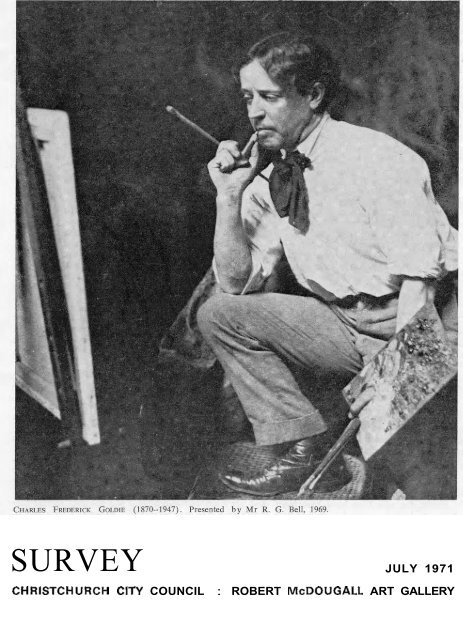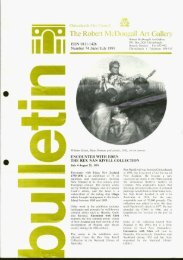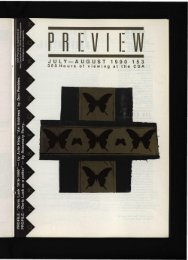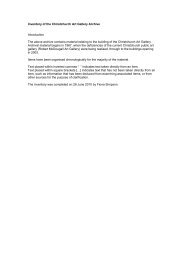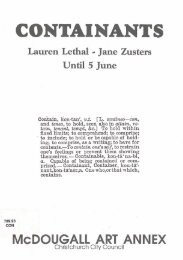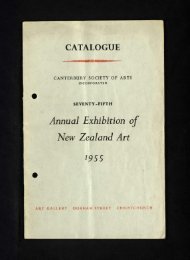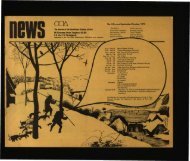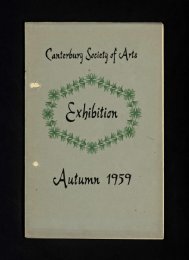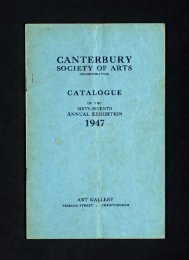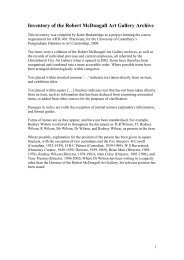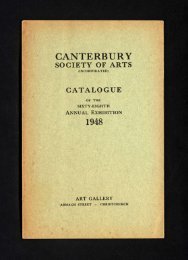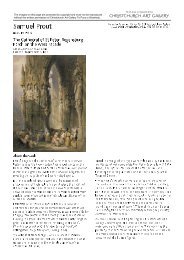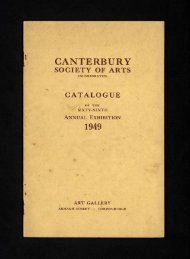Download (1.9 MB) - Christchurch Art Gallery
Download (1.9 MB) - Christchurch Art Gallery
Download (1.9 MB) - Christchurch Art Gallery
You also want an ePaper? Increase the reach of your titles
YUMPU automatically turns print PDFs into web optimized ePapers that Google loves.
SURVEY JULY 1971<br />
CHRISTCHURCH CITY COUNCIL : ROBERT McDOUGALL ART GALLERY
Getting to know the <strong>Gallery</strong><br />
THIS<br />
is the second appearance of the McDougall <strong>Art</strong> <strong>Gallery</strong>'s own publication 'Survey'.<br />
In this edition, some recent additions to the Collection are featured, along with a complete summary<br />
of acquisitions either purchased or donated since the publication of Volume One.<br />
On this oucasion, we are featuring the work of C. F. Gddie, since the <strong>Gallery</strong> was fortunate to receive<br />
recently, another of his oils. Entitled 'Rapaka, an Arawa Chieftainess', this particular painting has been<br />
donated by Mr and Mrs Geoffrey Wood of <strong>Christchurch</strong>. This now brings the total number of Goldies<br />
in the Collection to five, ali of which are currently on exhibition in the section devoted to New Zealand<br />
oils. The presentation of this painting has provided an opportune moment for us to try to make a<br />
more objective assessment of Goldie's work than seems so often to have been the case in recent years,<br />
and we have attempted to do this regardless of the commercial value placed upon his work and evi-<br />
denced by prices which his pintings have been bringing at recent auctions throughout the country.<br />
It is important, however, to remember that the ideas expressed through these pages are those d the<br />
writers themselves, based upon their study and thoughts on the particular topilc, and aimed not at<br />
providing a ready-made or positive solution to a question or problem, but at stimulating an interest<br />
in the subject for the reader.<br />
There is no easy way to gain an understanding or an appreciation of art. Like all other subjects<br />
it can be approached from a number of avenues. T1here are those who (often instinctively but #more<br />
often with at least some additional training or assistance) produce it. There are those who (though<br />
they may not always produce it), study it. There are those who follow it as an interest and, of course,<br />
there are those who have no intetrest in it at all. Yet all have the opportunity to become acquainted or<br />
better acquainted with art and the portion of our way of life which it occupies or represents. These op-<br />
portunities are presented to the public largely by means of the public library and the public art gal-<br />
lery. These two institutions seem not only to be allied, but indispensable for the fullest possible<br />
understanding 'of art at all levels and for all periods of history.<br />
For most people it is simply not enough to visit the entirely artificial environment of an art gal-<br />
lery and for them to expect to be able to appreciate, on the spot, all-or even part-of what they<br />
are looking at. Such a statement is not meant as any reflection upon such !people. As individuals in<br />
the society of the late twentieth century, everyone is faced with an apparently incomprehensible and<br />
impenetrable tangle of subjects and sciences, made ever-increasingly confusing by the mass news media<br />
which exists supposedly to enlighten us.<br />
How else, though, can one really colme to terms with examples of particular periods and art move-<br />
ments, in a gallery, unless one is prepared firstly, either to be totally unbiased and non-critical, or at<br />
least to attempt to study the su~bject?<br />
A visit to the gallery, a question posed by a particular painting or sculpture, a visit to the library,<br />
followed by a return visit to the gallery, forms a much more enlightened approach, and one which<br />
should result in a much greater appreciation and understanding.<br />
The word 'like' or 'love' of art, or of a particular work of art, has not so far been used because<br />
this is a much more individual and personal thing, and is usually quite unobjective.<br />
A full appreciation and enjoyment of a work of art must include oibjectivity. Unfortunately it is with-<br />
out this essential quality or basis for appreciation, that so many people approach art and the 'public<br />
gallery.<br />
This <strong>Gallery</strong>, however, is constantly aiming at trying to assist people with this problem.<br />
Firstly, the collections have been hung (and are frequently re-organised and re-hung) so that they<br />
are in a chronological order. In this way, it is hoped that the visitor will - even unconsciously -<br />
get the feeling d progressing through time. For example, the oldest painting in the European Collec-<br />
tion is by a Dutch painter, Jan van Goyen (1596- 1659) and since it is the oldest, it is the first paint-<br />
ing hung in the European Collection. Tt is followed by those. including examples from other coun-<br />
tries, which came after it in time, right up to recent times.<br />
The same thing will be disoovered in the section devoted to British watercolour paintings, and<br />
also with the New Zealand Collection. Because watercolour painting in Britain was at its peak during<br />
the last century and because it (naturally) had such an impact on all paintings done in New Zealand<br />
at that time, separate sections of the <strong>Gallery</strong> have been devoted to these. As a result, one first enters
the New Zealand section through the collection of New Zealand nineteenth century watercolours.<br />
These begin, once again, with the earliest and end with the most rent. The oils are hung in the<br />
same way. While not everything the <strong>Gallery</strong> owns is hanging, or is ever likeiy to be hanging, at one<br />
time, what is aimed at is a representation of periods. art movenients, or particular artists' work.<br />
A second feature to look for in the <strong>Gallery</strong> is development, or rathcr change d style, which is also<br />
shown by this method of presentation. It is interesting lor the visitor to be able to compare, for<br />
example, paintings of thc romantic movement done in Europe with those done in New Zealand at or<br />
about the same time.<br />
Nu suggestion is implied that this is the only method, or wen the most successful method of enhi-<br />
bitian in n gallery, but it is the one which at the moment anyway seems to suit most of the functions<br />
and requirements of the <strong>Gallery</strong> and ils audience. It is es.pecially uselul lor lessons with proups of<br />
school children, and it is imprhnt since this is one aspect of the <strong>Gallery</strong>'s function which is being<br />
given a considerable degree of attention.<br />
As well as having thecollections hanging in chronological sequence and thus trying to make thm<br />
more mneanin&ul, a start has been made recenlly on providing a greater amount of information upart<br />
from individual labels. This is being done in the form of text and diagrams provided with the art<br />
works. No attempt is made to explain or to interpret individual art works themselves. The aim is to<br />
give the visitor an insight into the period in which it was produced, the way in which it was pro-<br />
duced and its relative importance in history and to the Collection as a whole.<br />
In addition to these methods of piesentntion, there is this publication itself. which, it is hoped, will<br />
also assist in introducing the <strong>Gallery</strong> or in inducing one to embark upon an appreciative study of<br />
the subject. Finally, there is the educational programme for schools which the <strong>Gallery</strong>, in association<br />
with the Secondary Division of the <strong>Christchurch</strong> Teachers' Training College. stated lust year for school<br />
parties visiting the <strong>Gallery</strong>.<br />
None of these methods is claimed to be fully effedivc, or even more than experimental in some<br />
cases. What is being attempled is the provision of insight into this very important 'part of our lives. For<br />
too long The place, the function and in fact the meaning and enjoyment of what are often called the<br />
fine arls, in society us a whalc, has been misunderstood or misapplied and consequently removed, iso-<br />
lated and neglected by all but a small group of connoisseum or specialists.<br />
The <strong>Gallery</strong> staff hope that it it possible for those who devote their whole time to the subjert to<br />
make these things called art more meaningful and enjoyilblc lo more and more people.<br />
To hope to achieve such an aim requires, on the part of everyone, im interest, and an ability to<br />
look, think and learn. Above all, it requires patience. Bul perhaps that is the essence of a cultura<br />
as u way of life, and of civilisation, which is composed of the most highlyileveloped aspects of a<br />
people's culture.<br />
It is for that reason that efforts are being made, not only to bring children into contact with their<br />
artistic and cultural badigraund, but also to make it .more meaningful to them in terms of their<br />
everyday life, development and even their entertainment.<br />
Mis 1. Goldstein, one of the student-tcachers reconliy assigned to the <strong>Gallery</strong> for a few weeks'<br />
study and teaching practice, has provided same of her thoughts on the schcme in practice, and her<br />
contribution makes up the other major ,part of this edition.<br />
It is hoped that these facilities will assist many people to became mare familiar not only with their<br />
art gallery but also with particular aspects of our culture which it repicsents - the paintings, sculptures<br />
and other unique creations, which are the product of a certain high degree of the combination of sk&<br />
ful eyes, hands and intellect of mankind.<br />
BRIAN MUIR
Charles Frederick Goldie I 8 70- I 947<br />
THE <strong>Gallery</strong> was most forlunate recently to re-<br />
ceive & fine iilllc oil by C. F. Goldie. The portrait<br />
of Rakapa, an Arawa Chieftilincss, was donated<br />
by Mr and Mrs Gmffrey Wood or Christchhurch.<br />
The addition of this pinting brings the Gal-<br />
Icry's calieclion of Goldics to five, and these,<br />
along with two Lindauers, an early Sydney<br />
Thompson and sevcnl Van der Veldens, foim an<br />
impicssive collection of Romilntic portr d~lurc. .<br />
Pcrhaps at this point a note ol qualification<br />
should bc added. 'Romantic' has lately become a<br />
veiy loose tsrnm. 11 np ionser delines just u dislinct<br />
hislorical imovcmcnl in painling, iiterature and<br />
music, but can also be seen as an aspect -<br />
be il philosophicai. social or cultural - of the<br />
art of almost any pcriod of lime, including that<br />
of the present.<br />
The portraits in qualion are romanlic in feel-<br />
ing and mmxi and a certain nostalgia is ondoubt-<br />
edly present. The subjects, espcciully of Lhe Gold-<br />
ies and Lindauers. are proud and airoganl, but<br />
destincd to be quickly overcomc by the lwcnlieth<br />
century. Although Goldie's work relates la an<br />
early period of painling in NEW Zaiund, it does<br />
seem pcrtii~ent at lhis time to examine it a littie<br />
mare closely, especially since it seems to have<br />
found a new popularity and is bringing increasing<br />
prices on the auclion markel.<br />
Charlcs Frederick Goldie, O.B.E. was born<br />
in Aockland in 1870 He was tho son of a Mayor<br />
of Auilhlvnd and the grandson of a little-known<br />
English artist called Parlington. The young Goldie<br />
soon displayed considerdble talent a1 drawing and<br />
after a brief period in his father's limber business<br />
was sent, in 1892, to Paris lo furthei llis studies.<br />
Goidic shtdied at L'AeadCmie Julian with Bou-<br />
guerau, who wi?s the most revered academic<br />
paintcr or the lime. Goldie quickly confirmed his<br />
early talent, excelling at portraiture and the an-<br />
tique.' He completed a traditional training by<br />
encculing many copies of the old maslcrs at the<br />
Louvre and travelling throughout Europe, visiting<br />
museums and art gallerias.<br />
Goldie returned to Auckland in 1898 and<br />
established his studio in Shortland St. For some<br />
time he found it ditlimlt to make a living but<br />
soon attracted enough pupils to support himself.<br />
In 1899 he combined his talents with those of<br />
his former teacher, Louis John Steele, to produce<br />
'The study, particularly by drawing, of rhe clasrical<br />
works of art, ie. those of Greece and Romc.<br />
'The arrival of the Maoris in New Zealand':<br />
now in the Auckland City <strong>Art</strong> <strong>Gallery</strong>. This is<br />
a version of Gericault's haroic masterpiece of<br />
romantic pvinting 'The Raft of the Medusa'<br />
which now hangs in lhe Louvre, and which Goldie<br />
'n~usl have seen duriw his time in Paris.<br />
In 1901 Goldie made iiis first sketchimg lrip to<br />
the Rolorua district. He was so intrigued that it<br />
is icported that hc decided to devnle his time to<br />
prmlucing porlmits of the Maoris as he realised<br />
lhal the Lrvditioival Maori type was quickly bccoming<br />
somelhing of the past.<br />
It sezrnc, from all ucmunls, that Goldic was<br />
almmi sinslemindad in his attemot tn nrcserve<br />
ticism from the outset that his work lacked vaiicty.<br />
Because of this veiy restriotion. Goidic has<br />
became somewhnl of an enigma in tcims of New<br />
Zzaivnd art history. He did not desccnd to pas-<br />
tiche.' He could probably be described ,most<br />
accurately as a one-man academy, far no acad-<br />
emy such us that upon which Goldie had model-<br />
led himself enisred in Now Zealand at the time.<br />
It is revealing to look at the lime Goldie spent<br />
in Paris between 1892.1898, for these were years<br />
of intense artistic activily in France. Tnipiession-<br />
ism was an accepted fact. It was not merely a<br />
hollow revolution any more. Seurat, Van Gogh<br />
and Cbranne had all exhibiled, yet Goldic seems<br />
to to have been blissfully unconcerned with all<br />
this activiry.<br />
The fiw impresrionist exhibition was as early<br />
as 1x74, and while academic painters in France<br />
such as Bouguereau, Carmon. Caband. and Regn-<br />
auk were slili highly eslemed, their posilions and<br />
very existancc had ,been rcriously questioned by<br />
the new ihoughts and direclions that were appai-<br />
ent in painting.<br />
It must be remembered however, that at this<br />
Lime, there were two distinct 'movements within<br />
thc art world. The imorcssionists an one hand<br />
and the academic painters on the other. were<br />
both functionirg The fact that the impressionisls<br />
were ultimately the more impoflant movement is<br />
Bpparent today, yet to Goldie at the time. their<br />
discweria may not haw seemed so important.<br />
Coldie was the product of a h'iglily conserva-<br />
tive background, and by the time ha reached<br />
--<br />
'A work of ilit mado up from several style~ or in the<br />
style of another artist but presented a3 an independ-<br />
ent and original creation.
WHITENING SNOWS OF VENERABLE AGE. Oil on canvas, 8+ x 64. Robert Bell Bequest, 1943.
France many of his ideas about art may have<br />
been formed. Louis John Steele had already<br />
taught him lor some time.<br />
His training at VAcadkmie Julian reinforced<br />
these lradilional values and consequently he never<br />
broke away from then.<br />
As Goldie secms to have been unconcerned<br />
with the important impressionist developments.<br />
perhtps to his detriment, it remains to examine<br />
lhis woik within the field in which it was produced.<br />
Goldie ceitainly left behind him a fine and<br />
accurate record of the Maori of his limc. but<br />
little else. However, just as Galdie's painlings<br />
appeal to popular taste now, they served a simi.<br />
la role in his own day. Because of this very<br />
popularity ,and New Zealand's isolation from the<br />
mainstream of painting at the time. Galdie was<br />
. .<br />
~robablv iustifiablv satisfied that his woik was<br />
relevant.<br />
Everyone can superficially idcntfy with a Goldie<br />
It is plainly obvious 'what it is', but to lavish<br />
praisc on them for lhis reason is wrong. Similarly,<br />
it would be rash to label Goldie a great painter<br />
because of a technical facility for portraying such<br />
features as wrinkles and hair - his spmialitics.<br />
One often heair axlamations nf ~ ~ amazement at<br />
how 'life-like' Goidie's paintings are. Life-like<br />
perhaps, but more importantly, life-less. Painstaking<br />
observation and the rendering of exact<br />
detail alone, are not criteria on which to judge<br />
the quality irf a .painting. Furthermore they can<br />
never be satisfactory substitutes for expressiveness.<br />
Some pertinent questions to ask instead are<br />
what do Goldie's portraits tell us about the sitters?<br />
Do they contain an obvious sympathy for<br />
the subjact? Is there any warmth or human feeling?<br />
Does the painter identify with his subject or<br />
are the paintings no mere than clinical records of<br />
an era?<br />
Again it would be incorrect to say that Goldie's<br />
paintings are good hecause they are realistic. <strong>Art</strong><br />
can never be realivy. The simple fact that the<br />
artist tianslstes his vim, by hand. onto canvas<br />
with a brush, renders every #painting a ditkrant<br />
version of what we regard as visual reality.<br />
Finally it becomes a matter of expectation.<br />
Should we cxpmt Goldie to have done more<br />
than record his subjects? Wilhin his cornparatively<br />
'modest aims, however, Goldie succeeded<br />
admirably. Technically his paintings are superb<br />
and show undeniable skill and achievement. His<br />
torically they fulfll their function of recording<br />
a dying era in the history of the Maori. Finally<br />
they provide New Zealand portrait painting wit,)<br />
sound, traditional, academic ,principles and stand-<br />
ards as substantial as those of the British and<br />
Frcncb Academies.<br />
One of the most imponant criticisms that can<br />
juslly bc levelled at Goldie's painting, as has<br />
already been indicated, is that even though super-<br />
ficially his poitraits are realistic, they are essen-<br />
tially lifeless. They do not contain enough ,feel-<br />
ing lo convince one that these were living people.<br />
They do not vibrate with life, there is no 'prc.<br />
sence' about them. so that they become rather<br />
sad rmoids of a former time.<br />
Perhaps this very quality. is what denies<br />
Goldie a rank amongst the major portrait paint-<br />
ers. His portmits do not capture rhai essential<br />
spark of life and consequently do little but re-<br />
cord.<br />
It is interesting to compare Goldie's painting<br />
with the paintings of the American West by Fred-<br />
oric Rcmington which have been touring New<br />
Zealand this year. Remington enjoys a popular-<br />
ity thai is similar to that of Galdie and again like<br />
Goldie, he ,pursued the theme of painting and<br />
illustrating life in the pioneering period of Ameri-<br />
can hislory.<br />
ROSS MARWICK<br />
Further reading: For further information, the<br />
following books are suggested:<br />
'Ncw Zealand <strong>Art</strong>, A Centennial Exhibition' - talaiogue,<br />
National Centennial Exhibition. (Wellington,<br />
,"A,,3 .,.-,,,.<br />
'Paintings of Old New Zealand'- James Cowan (Auckland,<br />
1930).<br />
'New Zcaland Painling-A" Infroduction'-Gordon<br />
H. Brown and Hamish Keith. (Aucklsnd. 1969.)<br />
Othec examples of Galdie's woik in the MsDougall<br />
<strong>Gallery</strong><br />
(All are oils on canvar. Moaauremenla are in inchc.,<br />
height before width.)<br />
Thir Sirc Prow~xoncr<br />
A Hd Day 161x 131 Purchased 1902 by<br />
Cantorbur" Socletv of<br />
Whilening Snows of 8tx 6i<br />
Venerablc Ago<br />
Robert Bell Beqnesr.<br />
1943.<br />
EnaTePapatahi 191x23j Iamiesou Collection.<br />
Pie;entcd 1932.<br />
Ofher placer in New Zealand ",hers<br />
may be seen:<br />
Goldie'n work<br />
Auskland: City <strong>Art</strong> <strong>Gallery</strong><br />
Wac Memorial Museum<br />
Wanpami: Sarjeanl <strong>Art</strong> <strong>Gallery</strong><br />
Martenon: ~airvapa Anr Centre<br />
Wellington: National <strong>Art</strong> <strong>Gallery</strong><br />
g el son: nixhop Surer A* ~aller!<br />
Timaru: Aigantighe A* <strong>Gallery</strong><br />
Dunedin: Public An <strong>Gallery</strong>
'CORSICAN GYPSY'. Etching, 84 x 5). Ernest Heber<br />
Thompson, R.E. Purchased 1971.<br />
Until the recent acquisition of an excellent ex-<br />
ample of his etching work, Heber Thompson was<br />
previously unrepresented in the Collection. He<br />
,was born and educated in Dunedin and after<br />
serving in World War I he went to London,<br />
where he studied at the Slade School of <strong>Art</strong>. He<br />
was tutored there )by Wilson Steer, Sir Walter<br />
Russell and Sir Frank Short. (The <strong>Gallery</strong> has<br />
examples of the latter's work). His work was ex-<br />
hibited at the Royal Academy, the New English<br />
<strong>Art</strong> Club, the Royal Society d Painter-Etchers,<br />
the Royal Portrait Society and in exhibitions<br />
morganised by the British Council. Until retire-<br />
ment, he taught at Hornsey College of <strong>Art</strong> and<br />
(was from 1951 - 1966, the representative of the<br />
National <strong>Art</strong> <strong>Gallery</strong> of New Zealand in London.<br />
Other 'works by Heber Thompson may be seen<br />
in the Chicago Institute of Fine <strong>Art</strong>s, The Ash-<br />
molean Museum, Oxford, Bradford and Harro-<br />
gate <strong>Art</strong> Galleries in Britain, as well as in col-<br />
lections in New Zealand.<br />
Wellington : National <strong>Art</strong> <strong>Gallery</strong>.<br />
Dunedin : Public <strong>Art</strong> <strong>Gallery</strong>.<br />
Canterbury Regional<br />
-<br />
<strong>Art</strong>s Federation<br />
In September 1969 a widely-representative<br />
gathering of painters, musicians, potters, composers,<br />
sculptors and artists met to discuss the establishment<br />
of a national organisation which would<br />
represent the views, and defend (the causes, of<br />
the practising artist in New Zealand. Thus came<br />
into existence the National <strong>Art</strong>s Federation, a<br />
body separate from the Queen Elizabeth I1 <strong>Art</strong>s<br />
Council (a grant-giving national institution) and<br />
the N.Z.B.C. (an employing and commissioning<br />
agency so far as artists are concerned) but capable<br />
of complementing these bodies' activities.<br />
Auckland and Wellington Regional <strong>Art</strong>s Federations<br />
were set up at the beginning of 1970,<br />
and in June of the same year a meeting was<br />
held in <strong>Christchurch</strong> to find out whether the<br />
artistic community ,was in favour of establishing<br />
a regional arts federation for the Canterbury<br />
area.<br />
The idea (met with approval and a provisional<br />
executive was elected which has spent the time<br />
since then drawing up a constitution and informing<br />
all local arts organisations of the Federation's<br />
existence and explaining its objectives, the main<br />
one of which is to act as a clearing house for<br />
the aspirations, problems, and grievances of the<br />
artists and organisations involved in the arts in<br />
its community. It is hoped that the Federation<br />
will have direct contact with Councils and businesses<br />
in the area with a view to their greater<br />
participation in the arts.<br />
There is most assuredly a need for co-operation,<br />
co-ordination and strength-one voice to be<br />
representative of the arts as a whole, and d<br />
the individuals concerned
The Studenc-teacher<br />
Scheme in Practice<br />
In the last issue of 'Survay' Mr Brian Muir<br />
ontlined the scheme whereby a student-leacher<br />
from the <strong>Christchurch</strong> Teachers' College Secondary<br />
Division would periodically be in altendance<br />
at the <strong>Gallery</strong>, mainly to organkc and assist<br />
visiting school parlies.<br />
As the student-teacher recently seconded la the<br />
<strong>Gallery</strong>, Mr Muiv has invited me to give my<br />
impressions.<br />
It seems to me that the aims are as follows.<br />
Mr Muir intends the <strong>Gallery</strong> to be 'used' in<br />
the fullest sense and no1 allowed lo become simply<br />
a static museum aiece. To further this aim. lhe<br />
walls are kept frcih and pristine: 'painting labels<br />
are checked frequently foi necessary replacsment;<br />
temporary cnhibitions are changed at regular in.<br />
tervals nnd [lie whole gallery is brightly illurninared<br />
He is also keen that people, not only children,<br />
should be aware that works, including iprints,<br />
shown in the cdlery are original works of artists.<br />
and this is often not understood. An eflart is<br />
made also to show why original works are more<br />
valid than repioductions, for whilst art books have<br />
their place, dour rarely reproduces accumtely<br />
and the rappoit betwoen the original art work<br />
and the spectator can never be achieved in the<br />
same way.<br />
<strong>Art</strong> history has recently become a subject for<br />
the University Entrance Examinalion and arl<br />
teachers are requested to see lhat pupils have<br />
good acquaintance with the works in the <strong>Gallery</strong>.<br />
New Zealand painling occupies part of tho syllabus<br />
and, at Mr Muir's suggestion, I made that<br />
arca 'my own' with a view to supplementing the<br />
set tent book. The ,pupil's prime interest, unless<br />
already acquainted with Lhc <strong>Gallery</strong>, is to pass<br />
the coming examination, I. as a student-teacher.<br />
wish to help achieve this resull: as an artist my<br />
concern is the undeistanding of painting and finally<br />
us u mother and citizen my longterm aim is<br />
to foster the development of the visual arts by<br />
helnine to create a critical, but well-informed,<br />
pumblicr<br />
The hope is that the interweaving of various<br />
eom~nunity activities will bring tolerance of others<br />
and a more stable cultural climata. As the scheme<br />
operating in the <strong>Gallery</strong> is in its infancy, there<br />
is a need to feel the way.<br />
During the few weeks I spent at the <strong>Gallery</strong><br />
it was visited by a steady stream of school par-<br />
ties, numbers ranging from five lo lifty. In the<br />
main Lhcse were Rflh or sixth lormeis but includ-<br />
ed more senior sludcnts Irom the <strong>Christchurch</strong><br />
Technical College and a few younger pupils of<br />
the Form I and 11 levels.<br />
After consulling the class teacher regarding<br />
previous knowledge of pupils and any specific<br />
requiremenl, I was usually left to decide pro-<br />
cedure. I would spend appioximatcly one hour<br />
taking pupils through the New Zealand Collec-<br />
lion allcmpting to relate painlings to similar moue-<br />
ments in Europe and America, to try and show<br />
how nn art form, indigenous lo the counlry, has<br />
evolved (in spite of a national versus inlerna-<br />
lional battle) and how to look at the many facets<br />
of art individually as well us collectively and from<br />
differing viewpoinls. These poinls are namely,<br />
personal response to works of art, how require-<br />
'ments of good work are fulfilled and whelher it<br />
has a story or message and lhow 1ha arlisl has<br />
responded to artistic and environmental influ-<br />
enccs. More important, I hoped to encourage<br />
pupils to fann lhcir own opinions.<br />
Towards the cnd of my 'section' I found it<br />
was necessary to prcsent lhc European Collec-<br />
lion before showing works of New Zealand arlists<br />
as pupils seemed to have little or no knowledge<br />
of main movements or of major arlisls of any<br />
pcriod While in principle I felt this lo be right,<br />
in practise it proved to be loo much to fit into<br />
the time available.<br />
Perhaps the most refreshing classes are the<br />
younger one... Forms I to 111. Their response is<br />
iess inhibited. <strong>Art</strong> is primarily a visual experience<br />
and it was only in these classes that I could get<br />
a genuine revponsc to questions. More often than<br />
not. the senior pupils would show that they had<br />
listened to my words, but had railed to look.<br />
This is no doubt due to the impending State<br />
enuminatinns. The fifth fomms were often 'pupils<br />
in the art class because they had 'nothing better'<br />
to do. Not a very flattering or satisfactory situa-<br />
tion lor the art-teacher concerncd. It could only<br />
be hopcd thal a visit to the <strong>Gallery</strong> might en-<br />
courage any latent creativity in such students. I<br />
was astonished that so many pupils werc attmpt-<br />
ing University Entrance <strong>Art</strong> History without ever<br />
having made a ~praviaus visit to the <strong>Gallery</strong> to see<br />
examples of original art woiks.<br />
As a prospective teacher, I fell into the trap<br />
of trying to present too much at once. On the<br />
other #hand, I was painfully aware just how much<br />
has to be achieved in one short year.<br />
On reflection, certain changes would seem de-<br />
sirable. Firstly, visits to the <strong>Gallery</strong> and thereby<br />
preparation for University Entrance <strong>Art</strong> History
should start in the lower classes for all streams.<br />
These visits should ~ba at a general level and<br />
any specific points should be answered as they<br />
arise. Subsequent visits should be more frequent.<br />
Temporary exhibitions, in particular, may assist<br />
School Certificate pupils. Up to thirty pupils<br />
would be satisfactory and the numbers should<br />
decrease progressively, keeping in mind a more<br />
detailed programme. As the number of pupils<br />
decreases, there should be a corresponding in-<br />
crease in the number d visits during a school<br />
year. Sixth forms should have a maxhum of<br />
fifteen pupils and the art teacher could prearrange<br />
a progressive programme with the Director or<br />
the student-teacher. This could, (perhaps, be a<br />
series of classes, time being allowed for dims-<br />
sion. No doubt this happens back at school, but<br />
could {be held in a small room at the <strong>Gallery</strong><br />
where opportunity to return and refer directly to<br />
a specific work is possible.<br />
English and History students may also benefit<br />
!by studying painting and seeing how ideologies<br />
of a specific period tend to run parallel. For ex-<br />
ample, the genre painting of the Dutch middle-<br />
classes, the British reaction to Industrialism by<br />
the 'nature' painters and ~poets, and spray-paint-<br />
ing in an age of technology.<br />
My short period working at the <strong>Gallery</strong> rein-<br />
ford my opinion that it is important to show<br />
at an early age that art, like life and as an essen-<br />
tial part of life, is a continuum, and that one<br />
must constantly go on learning.<br />
JUNE GOLDSTEIN<br />
Recent student-on-section at the <strong>Gallery</strong>.<br />
RECENT ADDITIONS TO THE COLLECTION<br />
Donations (since 1st Jan. 1971)<br />
CHARLES BICKERTON, Cornish Scene. Pastel.<br />
Donated by Mrs M. Trail, <strong>Christchurch</strong>.<br />
ASTON GREATHEAD, Kitchen, Quail Flat<br />
Cookhouse, Kaikoura. Oil. Donated lby Mr P.<br />
J. Skellerup, <strong>Christchurch</strong>.<br />
BEATRICE PARTRIDGE, Taramakau River.<br />
Oil. Donated by family of the late Mr A. Moor-<br />
house, <strong>Christchurch</strong>.<br />
CORA WILDING, Taormina, Sicily, 1923. Oil.<br />
Donated by Mr E. A. F. Wilding, Parnassus.<br />
Purchases (since 1st Jan. 1971)<br />
NOLA BARRON, Sculptural Form, Ceramic;<br />
Candlestick. Ceramic.<br />
RUDOLF GOPAS, (b. 19 13) Movement in Space.<br />
Acrylic.<br />
DORIS LUSK, (b. 1916) Bettina. Watercolour.<br />
DOUGLAS McDIARMID, (ib. 1922) Still Life.<br />
Watercolour; Landscape in Landes. Water-<br />
colour.<br />
CHARLES MERYON, (1821-1868) La Rue de<br />
Mauvais Garpns. Etching.<br />
E. HEBER THOMPSON, Corsican Gypsy.<br />
Etching.<br />
Loans<br />
(a) from the School of Fins <strong>Art</strong>s, University d<br />
Canterbury : -<br />
ALFRED WALSH, Stream with Boulders.<br />
Watercolour.<br />
PETRUS VAN DER VELDEN, Estuary with<br />
Windmills, Oil; Nude Male Standing, Oil; Prow<br />
of Sailing Ship, Watercolour; Boys at Table<br />
with Waiter, Charcml and Watercolour; Trees<br />
at Otira, Pencil; City from Canal, PenciE: Cof-<br />
fin on Sledge-study for 'Dutch Funeral', Oil.<br />
ARCHIBALD F. NICOLL. Pastoral. Water-<br />
cdour.<br />
G. K. WEBBER, Trees and path. Watercolour.<br />
M. 0. STODDART, Primroses and Aspple Blos-<br />
som. Watercolour.
(,b) from the artist: -<br />
RUDOLF GOPAS, Interstellar, PVA and oil;<br />
Periphery of Time, PVA and oil; Core Element<br />
1971, PVA and d ; Circle of Warmth, PVA<br />
and oil; Cyclic Events (A tribute to Himalayan<br />
<strong>Art</strong>) PVA and oil.<br />
(c) from Miss Maureen Raymond :-<br />
SIR JACOB EPSTEIN. Air Marshal Viscount<br />
Poxihl. Bronze.<br />
EXHIBITIONS<br />
<strong>Art</strong> from Canada's West Coast. July 27 - Aug. 10.<br />
30 plus. Aug. 25 - Sept 13.<br />
Contemporary French Tapestries. Sept 15 - Oct 15.<br />
CHRISTCHURCH CITY COUNCIL<br />
CULTURAL COMMIlTEE<br />
The Mayor ,d Christcuhurch,<br />
Mr A. R. Guthrey, O.B.E., M.C.<br />
Councillor H. G. Hay, Chainman.<br />
Committee Members: Mrs H. L. Garrett; Messrs<br />
P. N. G. Blaxall, P. D. Dunbar, R. M. MacFar-<br />
lane, C. M. G., H. P. Smith, O.B.E., R. H. Still-<br />
well.<br />
Committee Clerk: H. G. Langley.<br />
Stafl :<br />
B. D. Muir, B.A. Dip.Tchg., Director<br />
R. H. Marwick, Dip. F.A. (Hons.), Assistant to<br />
Director.<br />
Mrs P. A. Clease, %retary.<br />
T. N. Gordon, Mrs J. Gordon,<br />
W. Cox, Custodians.<br />
Location: Botanic Gardens, Rolleston Avenue,<br />
<strong>Christchurch</strong>.<br />
Telephone : 40-754.<br />
Postal Address: P.O. Box 237, <strong>Christchurch</strong>.<br />
<strong>Gallery</strong> hours :<br />
Manday to Saturday (inclusive)<br />
10.00 a.m. - 4.30 pm.<br />
Sunday<br />
2.00 - 4.30 p.m.<br />
Public Holidays<br />
10.00 a.m. - 4.30 p.m.<br />
The Robert McDougall <strong>Art</strong> <strong>Gallery</strong> 'Suxvey' is<br />
published by the <strong>Christchurch</strong> City Council Cul-<br />
tural Committee and is concerned primarily with<br />
presenting information about the activities of<br />
the <strong>Gallery</strong> and works of art acquired by the<br />
<strong>Gallery</strong>.<br />
Editor: B. D. Muir.<br />
Printed (by: The Caxton Press<br />
113 Victoria Street, <strong>Christchurch</strong>.


